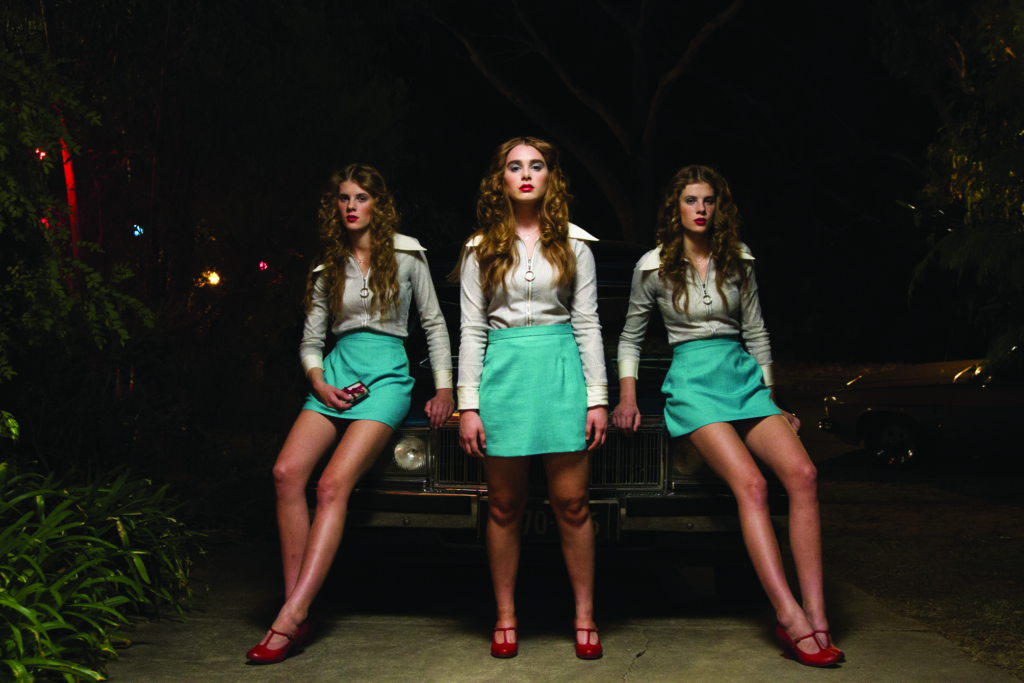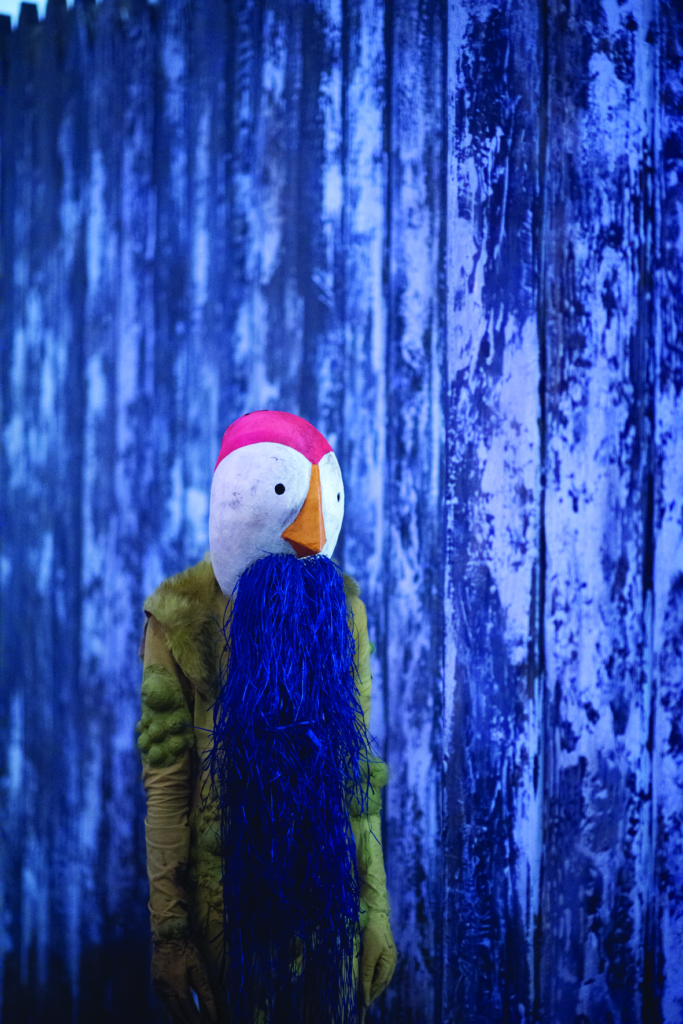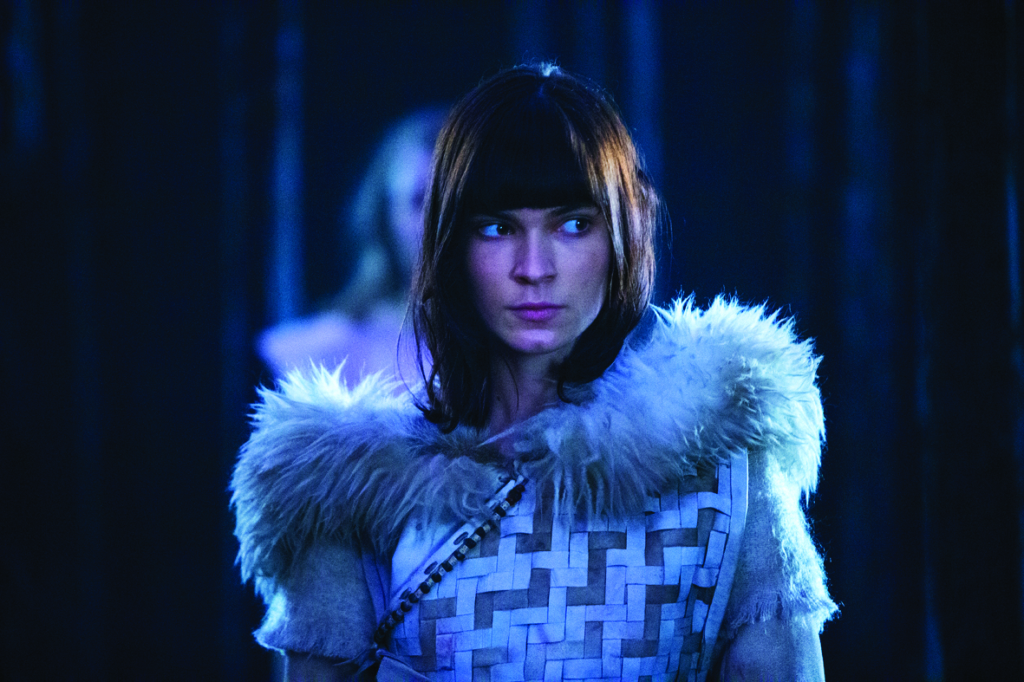The temptation to classify Girl Asleep (Rosemary Myers, 2015) as some kind of Australian Moonrise Kingdom (2012) is a difficult one to suppress. Aesthetically, the film is undeniably influenced by the latter’s director, Wes Anderson, something the filmmakers themselves are quick to draw attention to.[1]See, for example, Philippa Hawker, ‘Girl Asleep: Rosemary Myers on Adolescent Dreams, Dagginess, Desires’, The Australian, 20 August 2016, <http://www.theaustralian.com.au/arts/review/girl-asleep-rosemary-myers-on-adolescent-dreams-dagginess-desires/news-story/3a42c3c768aa1640136043573ed03efe>, accessed 25 October 2016. Symmetrical shots are frequent, and there is a bold, clearly defined colour palette present throughout. The plot centres on a young girl orbited by a series of eccentric characters; the costumes are striking, and the atmosphere, whimsical. To continue the comparison beyond the aesthetic, however, would do a disservice to the strange, uniquely Australian beast that is Girl Asleep. The debut film by veteran theatre-makers Myers, who directed, and Matthew Whittet, who wrote the script, combines the best aspects of their storytelling experiences with the freshness that can only come from having no prior movie-making hang-ups.
Running at only seventy-seven minutes, the film has a simple premise: ‘It’s the story of protagonist Greta Driscoll [Bethany Whitmore], who survives being a teenager by playing it under the radar,’ Myers tells me. ‘Then her parents decide to hold her a fifteenth birthday party […] and it’s kind of the worst news in the world to her.’ Beyond this, the quiet teenager finds herself in the middle of a social dilemma: accept the friendly overtures of the sweet but dorky Elliott (Harrison Feldman), or subject herself to the iron rule of her class’s queen bee, Jade (Maiah Stewardson), and disappear into reflected popularity. Passive in personality and unsure of what she wants, Greta takes the path of least resistance, inadvertently slighting Jade and her lackeys, who hold the most social power at their school.
Back at home, Greta’s parents are less and less able to control her rebellious older sister, Genevieve (Imogen Archer), who is beginning to embrace all the new liberties becoming available to women in the 1970s, when the film is set. The girls’ father’s (Whittet) approach to their increasing maturity is denial, clinging to the same daggy jokes around the dinner table. In contrast, Greta’s mother (Amber McMahon) tries to work through her frustration by funnelling all her energy into throwing her youngest daughter a well-intentioned birthday party, which the teenager really doesn’t want. On the night of the party, all of Greta’s growing problems converge in one place – her social standing at school, the direction of her relationship with Elliott, and the inescapable reality of decisions she will soon be forced to make. She escapes first to her room, then to sleep, then into a dream world where her abstract concerns become literal dangers.

Framing the film’s main complication as a girl’s reluctance to attend a party thrown in her honour may sound flimsy on the surface, but this is a deliberate and calculated move on the filmmakers’ part. ‘When you’re a teenager, the stakes of everything just feel enormous,’ Myers points out. Usually, stories about this time of life focus on the idea of a person ‘finding themselves’, but Girl Asleep approaches this from a contrasting angle. For Greta, the idea of turning fifteen and facing an unwelcome and rapidly approaching maturity is terrifying – and having a party to celebrate this thereby goes against all of her natural instincts. ‘I’d describe [the narrative] as a young girl’s journey into figuring out who she doesn’t want to be,’ Whittet explains.
Girl Asleep takes a tame approach to the coming-of-age genre, and herein lies one of its greatest strengths. There is no major traumatic event in Greta’s life to signify loss of innocence: she doesn’t suffer the death of a loved one, there’s no violent event, there is no big upheaval. Instead, the audience is given a glimpse into the brief window of her life during which, naturally yet reluctantly, she leaves childhood behind and moves forward into the unknown. ‘It’s a time that, if you’re not going through it, or about to go through it, you’ve [already] been through it,’ says Myers. Girl Asleep depicts this transition, not just with humour, but also with an edge of the sadness that isn’t often acknowledged in mainstream texts.
Girl Asleep takes a tame approach to the coming-of-age genre, and herein lies one of its greatest strengths. There is no major traumatic event in Greta’s life to signify loss of innocence.
When asked about the unwavering popularity of films with coming-of-age themes, Whittet replies, ‘There’s no shortage of them, that’s for certain.’
But I think that’s for a reason […] every story is about people changing in some way. Coming-of-age tales are just stories about young people – and where people are learning to grow up and change and understand themselves.
For adult viewers, a film like Girl Asleep comes with a sense of nostalgia, and can be enjoyed for its quirkiness and comedy. However, it is easy to forget, after we have all moved past the window that Greta is currently trapped in, how isolating and alienating the path to maturity can be. Coming-of-age films can be entertaining, yes – but, more than that, they are important for those going through the period of life being depicted. ‘It is a really formative time,’ says Myers, ‘as a child, you do really see yourself in relation to your parents and your family unit. Then suddenly, as a teenager, you start to understand yourself in relation to peers.’ Whittet expands on this idea:
When I was fourteen, fifteen, I was desperate to try to see myself reflected back at me in [creative work] – as most people actually do – or to see my experience reflected in some way. It’s such a rich and dynamic time of life, so full of change, and you’re showing pictures of what people are going to become as adults, in a way.

Change is a universal experience, and every incarnation we are exposed to is valid, valuable and provides solace to a teenager somewhere – or a reminder to an adult that we can all feel like freaks during adolescence. Fiction, whether in film or literature, provides what peers often cannot, or are too embarrassed to experience with us. It makes us less alone. Girl Asleep being so unmistakably Australian – with its accents, its architecture, its suburban setting – pushes this further, making it even more relatable to local audiences.
‘It is a really formative time … as a child, you do really see yourself in relation to your parents and your family unit. Then suddenly, as a teenager, you start to understand yourself in relation to peers.’
– Rosemary Myers
The changes Greta is going through are highlighted by the film’s time period – a time of upheaval that Myers was keen to explore. ‘The 1970s was kind of insane for women,’ she says.
I mean, women were expected to wear dresses, not pants, to a lot of workplace environments; they couldn’t get a loan from the bank without having a husband […] it’s just crazy stuff that seems unfathomable nowadays – and it’s actually not that long ago. I watch shows like Puberty Blues with my kids and they’d ask, ‘Was it really like that, where the girls sat on the beaches and got the boys sausage rolls?’ And it really was! It’s quite a shock to a modern young person.
For Greta, approaching maturity during this time of immense social change causes her to find herself being pulled yet again in two different directions, this time by the two women closest to her. As Myers explains:
In the mix, you’ve got Janet, her mother, who is more your traditional kind of homemaker. And then she’s got her older sister, Genevieve, who brings in this [wider] worldview through exotic pop music. It was a time for girls to really start to go, ‘Well, maybe I can have a career …’
There is certainly a lot going on under the 1970s-adorned surface of this film, but, even on a superficial level, it is enjoyable simply for its dialogue, its costuming and its unusual transitions. Every frame is used to maximum capacity – watch it once to take in the story, watch it a second time to fully enjoy the choreographed antics and visuals in the background.

Girl Asleep was originally a live production at South Australia’s Windmill Theatre and found new life as a film via the HIVE Fund. ‘It was this incredible initiative through Adelaide Film Festival, ABC, Australia Council for the Arts, and Screen Australia,’ Myers recounts. ‘It gave artists from outside the film world the opportunity to think about making a film […] it was like a dream come true for all of us.’ As this was Whittet’s first time writing a screenplay, he likens the experience to learning a new language, with the flexibility of film opening up a host of creative options.
Artistically, it was more [about] figuring out what not to say. On stage, we tend to use a lot more text and we’ll have much longer scenes. It’s a bit … talkier. This way, we don’t need two pages of dialogue; we can do it with three words and an image. That, for me, was a challenge – and very exciting.
The cross-pollination between screen and stage is readily apparent in the way the film looks. Transitions are eccentric; instead of an intertitle contextualising a situation, the text is embedded in the frame, interacting with the diegetic objects in the mise en scène. As the people behind the scenes are used to working with theatre’s limitations on space and set, the divide between camera and story is lessened; the audience is allowed a kind of intimacy that film doesn’t often offer. Asked about how his theatre background informed the unique voice of Girl Asleep, Whittet enthusiastically pinpoints how the creative team had innovated since the draft’s very first incarnation, deciding, ‘Let’s just be playful and imaginative and make leaps.’

While theatregoers and movie-watchers are not mutually exclusive groups, there are certain expectations that arise from the difference between the formats, so trying to bridge this gap immediately posed difficulties for Girl Asleep’s makers. The film takes risks, both in imagery and in storyline – and, for the most part, this has paid off. In particular, about two-thirds of the way through, things change abruptly as Greta enters her dream world. Familiar characters appear in fantastical costumes; her father becomes a slime-covered monster, and her mother, an icy villain. As a storytelling device, dream sequences are not uncommon but, in the case of Girl Asleep, this technique is a keystone – just look at its title – that enables viewers to see inside the mind of the otherwise-very-reserved Greta. Even though, visually, this dream sequence is quite different from its stage iteration, its scenes look the most theatrical in the film as a whole. The effect will not be for everyone, and, had the adaptation been put into the hands of seasoned filmmakers, it would likely have been approached entirely differently. It’s just not what a cinema audience expects from a film.
But it works. Viewers have not only accepted the unexpected; they have embraced it. According to Myers, the film’s success ‘has been beyond our wildest dreams […] It’s been rolling out in independent cinemas across the world, and in festivals.’ In fact, in 2015, Girl Asleep was conferred the Audience Award for Most Popular Feature at the Adelaide Film Festival; then, in 2016, it took out Best Feature Film at the South Australian Screen Awards, The Age Critics’ Award for Best Australian Feature Film at the Melbourne International Film Festival, and the Grand Jury Prize at the Seattle International Film Festival. Significantly, it also won the CinéfestOZ Film Prize – Australia’s most lucrative film award – that year.

Given the way in which the film came about, it was never a sure bet. As Whittet puts it, Girl Asleep is ‘about expectations on people and how to survive adolescence, how to survive school, how to survive yourself’ and, in some ways, Greta’s eccentric coming of age marks the same for the Australian film industry. The film pushes against long-held expectations as it embraces new storytellers and techniques, and presents them to the world stage, with ever-growing achievements. ‘There’s a shift in theatre at the moment where people are desperately wanting to see Australian stories, and I feel like the same thing’s happening in [film and] television as well,’ Whittet adds. ‘You just hear so many English and American voices telling you things about their culture.’
Asked about the obstacle of getting audiences to watch Australian-made content, he suggests that, rather than being the result of cultural cringe, this is an issue of access.
I think people are hungry for it […] Audiences are fantastic, and they’re willing to go with things if they’re interesting and good and engaging, which I think a lot of Australian stuff is […] but, often, it’s a matter of getting out there, into the marketplaces. That is the hard bit – and staying on long enough so people actually see it.
Audiences are fantastic, and they’re willing to go with things if they’re interesting and good and engaging, which I think a lot of Australian stuff is … but, often, it’s a matter of getting out there, into the marketplaces.’
– Matthew Whittet
Distribution is a complex issue. Due to its success at festivals at home and around the world, Girl Asleep had already built up positive word-of-mouth ahead of its release in Australia, which meant audiences were primed to see it. But films that are released cold – direct to cinemas – have a sink-or-swim chance; if they don’t do well in their first few weeks, they’ll be pulled from the screen.[2]See Steve Dow, ‘What’s Wrong with Australian Cinema?’, The Guardian, 26 October 2014, <https://www.theguardian.com/film/2014/oct/26/australian-film-australian-audiences>, accessed 25 October 2016. Getting a project off the ground is challenge enough to begin with; without strong marketing ahead of release, films start off at a disadvantage, which means a lot of smaller, locally made films don’t stand a chance against the Hollywood publicity machine.[3]See Don Groves, ‘Australian Cinema in Crisis’, IF.com.au, 22 October 2014, <http://if.com.au/2014/10/21/article/Australiancinemaincrisis/VUOGYVXXEP.html>, accessed 25 October 2016; and Lauren Carroll Harris, ‘Window of Opportunity: The Future of Film Distribution in Australia’, Metro, no. 182, Spring 2014, pp. 98–103. ‘There’s been some really great films over the last two years, too, and it’s been really consistent,’ says Whittet. ‘I think we’re just, on the world scale, a small market. And I guess, the more agile we are, the more able we are to get those stories out to people.’

The success of Girl Asleep marks a significant moment for Australian cinema, and is a great source of hope as we reach what may become a turning point for the industry. For better or worse, we have consistently banked on our landscapes, our settings and our stereotypes to sell our films to the world at large. Now, it seems we are more willing to trust in our storytelling ability alone, allowing our culture to naturally seep through. With Girl Asleep’s trajectory arguably embodying a microcosm of its greater impact on the local screen industries, the questions Greta is forced to ask as she begins to hammer out her identity take on a larger meaning. Myers’ summary then stretches beyond the film’s protagonist and into the real world: ‘She’s asking herself fundamental questions. Who are you? Where do you sit in the social pecking order? How are you going to play it? Who are you going to be?’
Endnotes
| 1 | See, for example, Philippa Hawker, ‘Girl Asleep: Rosemary Myers on Adolescent Dreams, Dagginess, Desires’, The Australian, 20 August 2016, <http://www.theaustralian.com.au/arts/review/girl-asleep-rosemary-myers-on-adolescent-dreams-dagginess-desires/news-story/3a42c3c768aa1640136043573ed03efe>, accessed 25 October 2016. |
|---|---|
| 2 | See Steve Dow, ‘What’s Wrong with Australian Cinema?’, The Guardian, 26 October 2014, <https://www.theguardian.com/film/2014/oct/26/australian-film-australian-audiences>, accessed 25 October 2016. |
| 3 | See Don Groves, ‘Australian Cinema in Crisis’, IF.com.au, 22 October 2014, <http://if.com.au/2014/10/21/article/Australiancinemaincrisis/VUOGYVXXEP.html>, accessed 25 October 2016; and Lauren Carroll Harris, ‘Window of Opportunity: The Future of Film Distribution in Australia’, Metro, no. 182, Spring 2014, pp. 98–103. |





